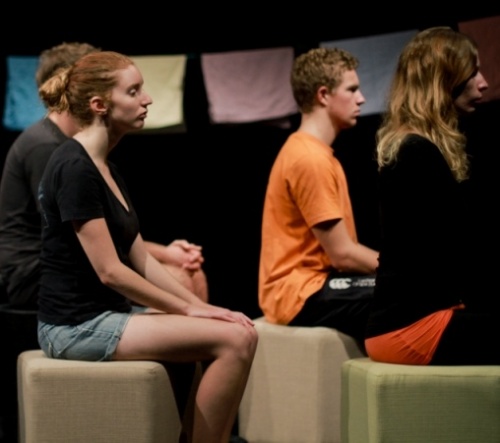INSTRUCTIONS FOR LIFE
Playhouse, Gallagher Academy of Performing Arts, Hamilton
16/05/2013 - 18/05/2013
06/06/2013 - 08/06/2013
Production Details
Carving in Ice Theatre’s Instructions for Life is an original work made from shared stories and intriguing interludes.
Being alive is a complex business and if there isn’t any definitive instruction manual, where and how are we getting information on what we should be doing? If there is a manual, who is writing it and is it successfully reaching its target audience? Are there any ‘gaps’ in the record and why do these occur? This snapshot montage of twenty-first century life shakes up the familiar and speaks to all the senses. Intimate, funny, whimsical, heartfelt and, at times, deeply distressing, it’s a home ground journey through those small moments which we all share. The perfect reaffirmation of what it is to be human and a reminder that there are glimpses of the extraordinary to be found within the most mundane pastimes. Instructions for Life confirms connection and hints at hitherto unimagined possibilities.
Playhouse, Gallagher Academy of Performing Arts, Hamilton:
May 16th, 17th, 18th – 7:30pm
Gaslight Theatre, Cambridge:
June 6th, 7th, 8th – 7:30pm, 9th – 2:00pm
Tickets: Concession/Student $15 | Adult $20
Bookings: www.ticketek.co.nz | 0800 TICKETEK
Ticketek booking fees may apply
For more info, please visit: www.carvinginice.co.nz
Enriching
Review by Gail Pittaway 17th May 2013
This play is a product of a devising process in which theatre students of the University of Waikato have explored non-narrative elements of performance. The piece is a series of episodes, all thematically based on giving ‘Instructions for Life while avoiding the suck of story, the pull of personality and character.
The cast, as themselves, interact in ways that sometimes seem improvised and at others highly rehearsed, to represent such invaluable gems as how to hug, how to say sorry, how to say good bye. The overall effect, often sweetly funny is strangely peaceful – reflective without being heavy.
Gaye Poole acknowledges the group processes in her programme note and modestly credits the actors and crew, but all credit to her for allowing such productions to occur, and to invite such provocative ideas from her cast as devising partners. Credit must also go to the lighting and sound crew who give a slick and professional impression to the show.
The evening opens in gloom; a scratch orchestra using found objects to roll, thump and scrape, acclimatises eyes and ears to a different mode from the ‘dramatic’ or conflict-driven story. The audience is made watchful, expectant, yet open.
A range of sequences unfold which use the entire cast of twelve adults and one delightful sprite-like child, weaving in and out of every day encounters, some silent, some with dialogue. Eight letters of apology or admiration are read out, apparently genuinely written by their readers. These alone are very fine pieces of nuanced writing – offering instances where sorry can become an accusation and admiration can be disappointment.
The stop-start nature of the evening and the tendency to involve all of the actors in most of the scenes slows it down to a Zen-like pace. By the second half, with more visual appeal as all the cast are glamorously clad in gowns or suits, this loop/ repetition of minimalism works well. There are several nice pieces of choreography delivered with acute timing, and the cast is uniformly excellent – it’s all an exemplary piece of ensemble performance.
In one sequence a lovely interaction occurs when, paired, in sequined gowns and shiny suits, each member of the cast wears a pillow case over her or his head. At a touch from the sprite-child, one at a time, they begin the old favourite of the drama class, the statues game. One person arranges the body of another into a pose, but then at another touch, still pillow-cased, and senses impeded, the shaper moves to fit into the pose – so one becomes a pair dancing; another is being comforted, or embraced, by another; then another two are competing in a race or as halves of a seesaw motion. It’s a touching piece about working together, fitting in while dancing in the dark and a fine example of the kind of group training and planning that will have created the whole show.
One disappointing sequence is when, in singles or groups, the cast use a vast supply of rice grains to make patterns on the stage, under indigo lights. The stage is too crowded and the seating too steep for this to be visible from every seat. But over all, these stage offerings are generously given and gladly accepted by an audience, which leaves not so much instructed as enriched.
Copyright © in the review belongs to the reviewer





Comments